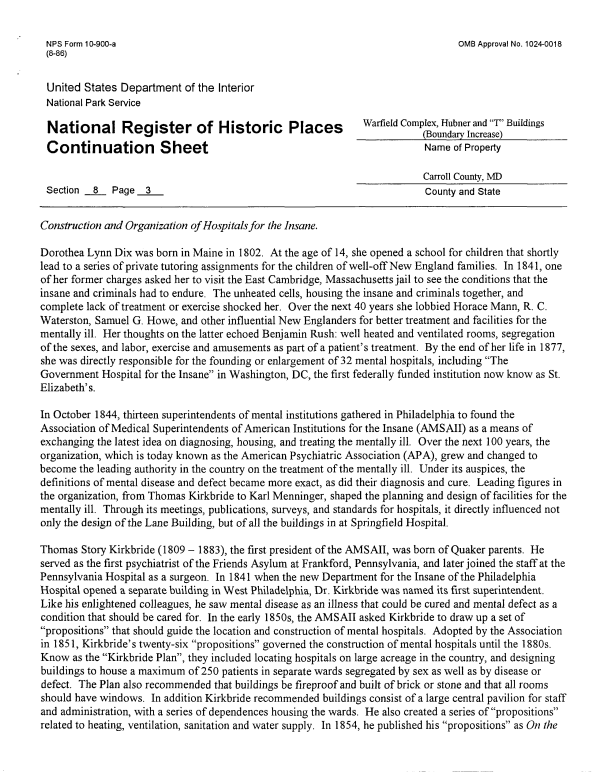 |
||||
|
DEPARTMENT OF HOUSING AND COMMUNITY DEVELOPMENT, MARYLAND HISTORICAL TRUST (Historic Sites Survey) var.d. MSA SE16-7 Image No: se16-7-0316 Enlarge and print image (89K) |
 |
||||
|
DEPARTMENT OF HOUSING AND COMMUNITY DEVELOPMENT, MARYLAND HISTORICAL TRUST (Historic Sites Survey) var.d. MSA SE16-7 Image No: se16-7-0316 Enlarge and print image (89K) |
| NFS Form 10-900-a OMB Approval No. 1024-0018 (8-86) United States Department of the Interior National Park Service National Register of Historic Places __________ Continuation Sheet Name of Property Carroll County, MD Section 8 Page __3_ County and State Construction and Organization of Hospitals for the Insane. Dorothea Lynn Dix was born in Maine in 1802. At the age of 14, she opened a school for children that shortly lead to a series of private tutoring assignments for the children of well-off New England families. In 1841, one of her former charges asked her to visit the East Cambridge, Massachusetts jail to see the conditions that the insane and criminals had to endure. The unheated cells, housing the insane and criminals together, and complete lack of treatment or exercise shocked her. Over the next 40 years she lobbied Horace Mann, R. C. Waterston, Samuel G. Howe, and other influential New Englanders for better treatment and facilities for the mentally ill. Her thoughts on the latter echoed Benjamin Rush: well heated and ventilated rooms, segregation of the sexes, and labor, exercise and amusements as part of a patient's treatment. By the end of her life in 1877, she was directly responsible for the founding or enlargement of 32 mental hospitals, including "The Government Hospital for the Insane" in Washington, DC, the first federally funded institution now know as St. Elizabeth's. In October 1844, thirteen superintendents of mental institutions gathered in Philadelphia to found the Association of Medical Superintendents of American Institutions for the Insane (AMSAII) as a means of exchanging the latest idea on diagnosing, housing, and treating the mentally ill. Over the next 100 years, the organization, which is today known as the American Psychiatric Association (APA), grew and changed to become the leading authority in the country on the treatment of the mentally ill. Under its auspices, the definitions of mental disease and defect became more exact, as did their diagnosis and cure. Leading figures in the organization, from Thomas Kirkbride to Karl Menninger, shaped the planning and design of facilities for the mentally ill. Through its meetings, publications, surveys, and standards for hospitals, it directly influenced not only the design of the Lane Building, but of all the buildings in at Springfield Hospital. Thomas Story Kirkbride (1809 - 1883), the first president of the AMSAII, was born of Quaker parents. He served as the first psychiatrist of the Friends Asylum at Frankford, Pennsylvania, and later joined the staff at the Pennsylvania Hospital as a surgeon. In 1841 when the new Department for the Insane of the Philadelphia Hospital opened a separate building in West Philadelphia, Dr. Kirkbride was named its first superintendent. Like his enlightened colleagues, he saw mental disease as an illness that could be cured and mental defect as a condition that should be cared for. In the early 1850s, the AMSAII asked Kirkbride to draw up a set of "propositions" that should guide the location and construction of mental hospitals. Adopted by the Association in 1851, Kirkbride's twenty-six "propositions" governed the construction of mental hospitals until the 1880s. Know as the "Kirkbride Plan", they included locating hospitals on large acreage in the country, and designing buildings to house a maximum of 250 patients in separate wards segregated by sex as well as by disease or defect. The Plan also recommended that buildings be fireproof and built of brick or stone and that all rooms should have windows. In addition Kirkbride recommended buildings consist of a large central pavilion for staff and administration, with a series of dependences housing the wards. He also created a series of "propositions" related to heating, ventilation, sanitation and water supply. In 1854, he published his "propositions" as On the |